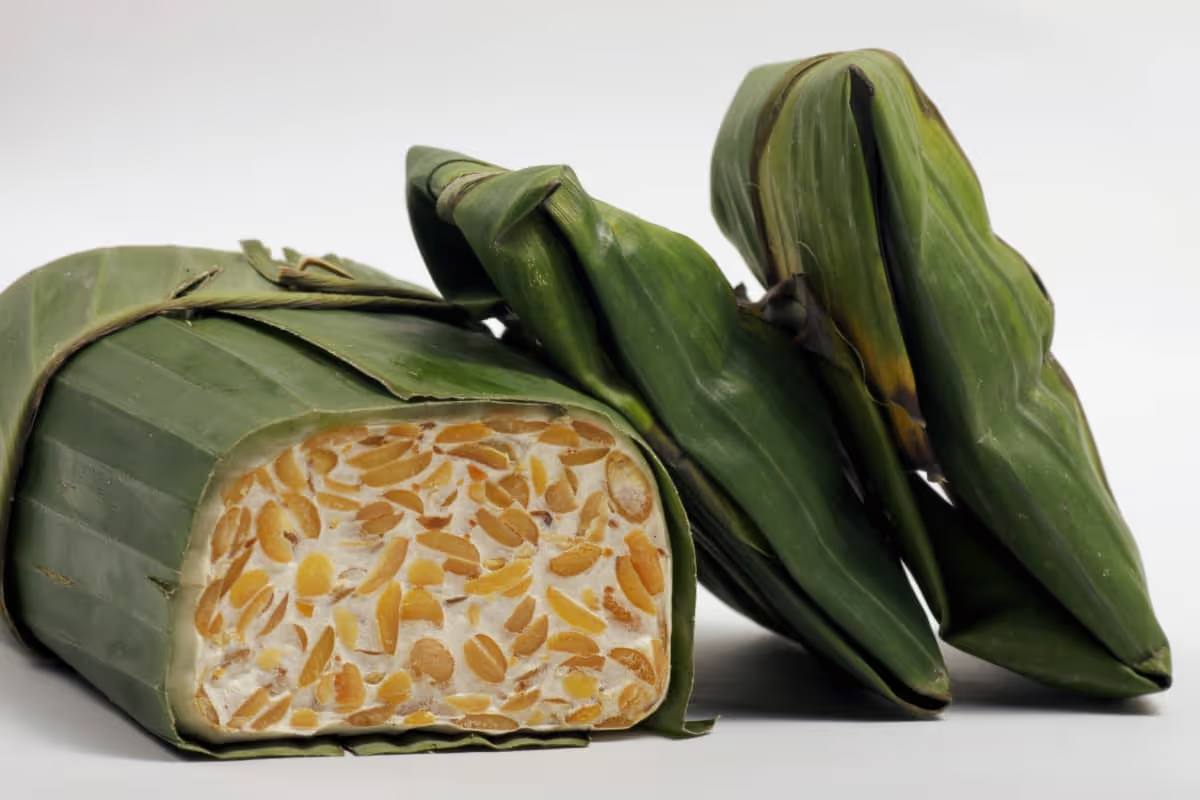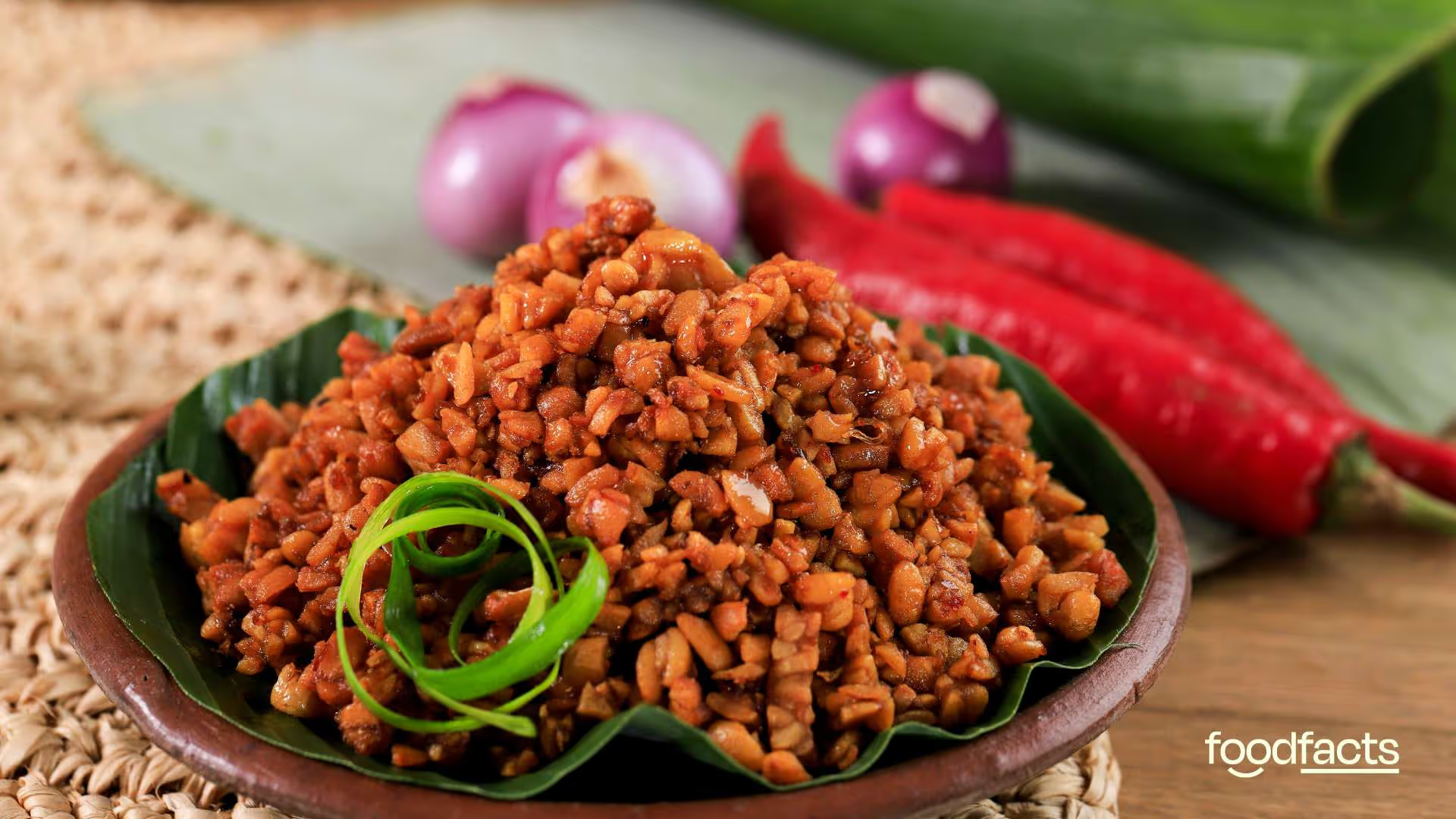
The high-protein, gut-friendly food that's been a staple for centuries. And it's going mainstream





Coral Red: Mostly False
Orange: Misleading
Yellow: Mostly True
Green: True
Learn more about our fact-checking policies
Tempeh, a traditional Indonesian fermented food, has been quietly nourishing communities for centuries with its impressive nutritional profile and distinctive nutty flavor. Today, this ancient protein source is experiencing a remarkable surge in popularity as health-conscious consumers worldwide discover its numerous benefits. This compact cake of fermented soybeans delivers a complete protein profile while offering gut-friendly probiotics, essential vitamins, and minerals that support overall wellbeing. As plant-based eating continues to gain momentum globally, tempeh stands out as an exceptionally versatile ingredient that satisfies discerning palates while providing substantial nutritional value without the environmental footprint of animal products.
The Ancient Origins of Tempeh
Tempeh's rich history dates back centuries to the island of Java in Indonesia. According to historical evidence, tempeh was first documented in Bayat, Klaten, Central Java, in the 1600s. The fascinating origin story suggests that tempeh was discovered serendipitously when cooked soybeans wrapped in tree leaves were left to ferment in Indonesia's warm, humid climate. What began as a chance discovery soon became an integral part of Indonesian cuisine and culture, spreading throughout the region.
The invention of tempeh likely occurred through the chance introduction of the Rhizopus fungus to stored soybeans. This fungus naturally grows on teakwood and sea hibiscus leaves, which Javanese people traditionally used as food wrappings. In traditional tempeh making, an "usar" (a mycelium-grown leaf) was used instead of commercially produced starter cultures that are common today. The earliest documented evidence of tempeh appears in Serat Centhini, a book published in the 16th century, indicating that tempeh production and consumption were already established practices by that time.
Initially, black soybeans native to the region were used to make tempeh. This practice later changed with the importation of white or yellow soybeans and the growth of the tofu industry on the island. The first European reference to tempeh appeared in 1875 in a Javanese-Dutch dictionary, marking the beginning of tempeh's introduction to the Western world. The traditional production methods evolved over time, with plastic bags eventually replacing banana leaves as containers for tempeh production in the 1970s. This innovation helped standardize the fermentation process and facilitated commercial production, setting the stage for tempeh's global journey that continues to accelerate today.

What Exactly is Tempeh?
Tempeh is a compact cake made from soybeans that have been cooked and then fermented with a specific culture, resulting in a firm, cake-like product with a distinctive nutty flavor. The production process involves soaking soybeans overnight, cooking them for approximately 30 minutes, and then mixing them with a tempeh starter culture, typically Rhizopus oligosporus, a fungus of the family Mucoraceae. During the fermentation period of 36 to 48 hours, the Rhizopus mold grows throughout the soybeans, binding them together and creating the characteristic solid texture that sets tempeh apart from other soy products.
Unlike tofu, which is made from soy milk and has a softer texture, tempeh retains the whole soybean and has a firmer, meatier bite that many find more satisfying. The textural difference makes tempeh particularly appealing as a meat substitute in various dishes. As Cleveland Clinic dietitian Gillian Culbertson explains, "With tempeh, I would almost describe it as having a meatier texture to it. It has more of a bite to it, whereas tofu is usually softer". The fermentation process also gives tempeh a more complex flavor profile compared to tofu, with notes often described as nutty or mushroom-like.
Though traditionally made with soybeans, tempeh can also be produced using other legumes, grains, and even seeds. Modern variations include multigrain tempeh (incorporating rice, wheat, or barley) and innovative varieties made from black-eyed beans, chickpeas, or other legumes. These alternatives offer different nutritional profiles and flavor experiences, expanding tempeh's versatility in the culinary world. The fermentation process not only enhances the food's digestibility but also increases its nutritional value by breaking down compounds that might otherwise inhibit nutrient absorption.
Nutritional Powerhouse: Breaking Down Tempeh's Benefits
Tempeh stands out as an exceptional nutritional powerhouse, particularly for those seeking plant-based protein sources. On average, a 100g serving of tempeh provides approximately 166 calories, a substantial 20.7g of protein, 6.4g of fat, 6.4g of carbohydrates, and an impressive 5.7g of fiber. This protein content makes tempeh especially valuable for vegetarians and vegans, as it contains all nine essential amino acids that the human body cannot produce on its own, qualifying it as a complete protein. The protein density of tempeh surpasses many other plant-based options, making it an efficient way to meet daily requirements.
The compactness of tempeh gives it a nutritional edge over other soy products. While 3 ounces (84 grams) of tempeh delivers about 15 grams of protein, the same amount of tofu contains only about 6 grams, representing a significant difference of approximately 40%. Beyond protein, tempeh provides substantial amounts of essential minerals including calcium (120mg per 100g), iron (3.6mg per 100g), and magnesium (70mg per 100g). These minerals play crucial roles in bone health, oxygen transport, and numerous enzymatic reactions in the body.
Tempeh is also remarkably rich in B vitamins, with a 3-ounce serving providing approximately 18% of the recommended daily intake of riboflavin and 12% of niacin. Additionally, tempeh can contain vitamin B12, which is relatively rare in plant foods and particularly valuable for those following plant-based diets who might otherwise struggle to meet their B12 requirements. The manganese content is especially notable, with a single serving providing 54% of the recommended daily intake. This trace mineral plays important roles in metabolism, bone formation, and antioxidant functions.
The fermentation process that creates tempeh brings additional nutritional benefits by breaking down anti-nutrients that might otherwise inhibit mineral absorption. This process essentially pre-digests some components of the soybeans, making tempeh easier to digest and its nutrients more bioavailable than those in unfermented soy products. For those monitoring their sodium intake, tempeh is naturally very low in sodium, containing only about 9 milligrams per 3-ounce serving, making it a heart-healthy protein option that can be seasoned according to individual preferences and dietary needs.
Health Benefits That Make Tempeh a Superfood
The health benefits of tempeh extend far beyond its impressive nutritional profile, making it a true superfood with multiple advantages for various aspects of health. The fermentation process creates prebiotic fiber, which feeds beneficial bacteria in the gut, helping them thrive and multiply. Though tempeh is cooked before consumption and some commercial varieties are pasteurized (potentially reducing live probiotic content), it remains rich in the type of fiber known to be prebiotic. The gut bacteria nourished by this fiber produce short-chain fatty acids that have beneficial effects not only on gut health but also on overall wellbeing.

Tempeh's high protein content makes it particularly effective for weight management. Protein has a well-documented satiating effect, which helps control appetite and potentially reduce overall calorie intake. The combination of protein and fiber in tempeh creates a feeling of fullness that typically lasts longer than many other foods, making it a valuable addition to a weight-conscious diet without sacrificing nutritional quality or satisfaction. For those looking to manage their weight while maintaining muscle mass, tempeh provides an excellent solution.
The soy isoflavones present in tempeh are powerful plant compounds with protective antioxidant properties that may help minimize damage caused by oxidative stress in the body. These phytoestrogens offer particular benefits for women's health, especially during and after menopause. Studies suggest that including soy foods like tempeh in the diet may contribute to reducing hot flashes and supporting bone health in post-menopausal women through improvements in bone metabolism. The compounds mimic some of estrogen's effects in the body, potentially helping to ease the transition through hormonal changes.
For cardiovascular health, tempeh offers multiple benefits that may contribute to a healthier heart. Research suggests that regular consumption of tempeh may help manage cholesterol levels, potentially reducing the risk of heart disease. The combination of fiber, unsaturated fats, and soy isoflavones contributes to this heart-friendly profile, making tempeh an excellent replacement for less healthy protein sources in the diet. The low sodium content of unflavored tempeh further enhances its cardiovascular benefits.
Recent research has also highlighted tempeh's potential role in athletic performance and recovery. The paraprobiotic properties of fermented foods like tempeh may help restore from fatigue and reduce anxiety in athletes. This is achieved through increased protein synthesis activity in pathways involved in the integrated stress response. Additionally, these paraprobiotics may help maintain mitochondrial function and support recovery from fatigue by preventing certain types of gene down-regulation associated with oxidative phosphorylation. For active individuals, incorporating tempeh into pre- or post-workout meals could potentially enhance performance and recovery.
How Tempeh is Going Mainstream In Western Markets
The rising popularity of plant-based diets has propelled tempeh from a niche vegetarian staple to a mainstream food product available in an increasing number of supermarkets and health food stores. No longer confined to specialty Asian grocery stores, tempeh can now be found in various forms across retail outlets, making it more accessible than ever before to curious consumers and those seeking sustainable protein alternatives.
The spread of tempeh from Indonesia to the UK, Europe, and the US was catalysed by migrations of Indonesians and collaborative research activities on tempeh fermentation. For example, some of the first scientific publications on tempeh fermentation in Dutch coincided with the Dutch colonialism in Indonesia (Ahnan-Winarno et al., 2021). Home fermentation movements and demands for plant-based proteins are thought to trigger larger tempeh productions that lead us to the current tempeh industries in those countries.

Commercially, there are a number of succesful brands, a stand out examples of tempeh's rise in popularity in the UK is Better Nature. Launched in 2020, this innovative brand has made significant strides in bringing tempeh to mainstream audiences. Their mission is to make wholefood proteins the norm, not the alternative, and they’ve done just that by securing listings in major retailers such as Tesco, Asda, Lidl, Ocado, Planet Organic, and Whole Foods Market. Better Nature has also become a best-seller on Amazon UK and has expanded into food service through partnerships with distributors like Bidfood, as well as entering the German market with leading retailers like Rewe and Tegut.
What makes Better Nature stand out is not just their rapid growth but their commitment to sustainability and community impact. As a certified B Corp™, they put people and the planet ahead of profit, donating 1% of their sales to tackle malnutrition in Indonesia, the birthplace of tempeh. Using sustainably grown, non-GMO soybeans, they ensure their tempeh has a low carbon footprint, verified by farm-to-fork analysis from My Emissions. Better Nature's success story highlights how tempeh is no longer a niche product but a dynamic and rapidly growing staple in the UK’s plant-based food scene.
How to Cook Tempeh: Simple Techniques for Delicious Results
One of tempeh's greatest attributes is its culinary versatility, which allows it to be prepared in numerous ways while maintaining its structural integrity and nutritional benefits. For those new to cooking with tempeh, understanding a few basic preparation techniques can help achieve delicious results consistently and build confidence in working with this nutritious ingredient.
A recommended first step when cooking tempeh is steaming, which helps soften the texture and allows it to absorb flavors more effectively. This process involves cutting the tempeh into your desired shape (cubes, slices, or triangles), placing it in a steamer basket over simmering water, covering, and steaming for approximately 10 minutes. While this additional step might seem unnecessary, it could improve the final dish by reducing any potential bitterness and enhancing tempeh's ability to absorb marinades. The brief steaming period opens up the dense structure of the tempeh, allowing flavors to penetrate more deeply.
Marinating tempeh is another key technique for developing flavor. An effective basic marinade might combine tamari or soy sauce (¼ cup), rice vinegar (2 tablespoons), maple syrup (2 tablespoons), olive oil (1 tablespoon), and sriracha (1 teaspoon) for a balance of salty, sweet, sour, and spicy notes. Even a brief 30-minute marination can infuse tempeh with considerable flavor, though longer marination times generally produce more flavorful results thanks to tempeh’s sponge-like mycelium formed during fermentation. The dense structure of tempeh allows it to hold up well during marination without becoming mushy, unlike some other protein alternatives.
Baking marinated tempeh offers perhaps the most straightforward cooking method and works well for beginners. After marinating, arrange the tempeh pieces on a parchment-lined baking sheet and bake at approximately 425°F (220°C) for about 20 minutes, turning halfway through and brushing with additional marinade for extra flavor development. The high heat creates a slightly crisp exterior while maintaining a tender interior, creating a pleasing textural contrast and caramelizing the sugars in the marinade for enhanced flavor.
For those who enjoy grilled foods, tempeh holds up exceptionally well on the grill. This method works best with larger pieces, such as triangular "steaks" or thick slices. After marinating, grill the tempeh over medium heat for 7-9 minutes until char marks form, then brush with more marinade, flip, and grill for another 4-5 minutes. The smoky flavor from grilling complements tempeh's natural nuttiness beautifully, creating a satisfying meat-like experience that even dedicated omnivores can appreciate.
In Indonesia, a common and beloved preparation involves slicing or dicing tempeh and frying until the surface is crisp and golden brown. This method highlights tempeh's ability to develop different textures based on cooking techniques. The crispy exterior and tender interior create a delightful contrast that makes fried tempeh pieces perfect for adding to salads, grain bowls, or enjoying as a protein-rich snack with dipping sauces. For a healthier alternative, air-frying can produce similar results with significantly less oil.
Incorporating Tempeh Into Your Daily Diet
Integrating tempeh into your regular meal rotation can transform your nutritional intake while expanding your culinary horizons. The beauty of tempeh lies in its adaptability—it works wonderfully as both a center-of-plate protein and as a complementary ingredient in complex dishes. For those new to tempeh, starting with familiar preparations can ease the transition and build appreciation for this nutritious food.
Breakfast offers an excellent opportunity to incorporate tempeh into your day. Crumbled and seasoned tempeh can serve as a nutritious alternative to breakfast meats alongside eggs or plant-based alternatives. Marinated tempeh slices can be pan-fried until crisp for a bacon-like addition to the morning meal, providing a protein-rich start to the day without processed meats. Tempeh also works beautifully in breakfast burritos, where its firm texture holds up well amidst other ingredients.

For lunch and dinner applications, tempeh shines in numerous roles across diverse culinary traditions. Cubed tempeh absorbs the flavors of curries, stews, and stir-fries while maintaining its structural integrity, unlike many other plant proteins that might break apart during cooking. This quality makes it particularly valuable in dishes with robust sauces where you want the protein component to remain distinct. The firm texture also makes tempeh an excellent candidate for skewers or kebabs, holding together beautifully on the grill.
Sandwiches and wraps benefit tremendously from marinated and grilled tempeh slices, which provide substantial protein and satisfying texture. A tempeh Reuben with sauerkraut and Russian dressing or a tempeh BLT showcases how effectively tempeh can step into traditionally meat-centric roles. The firm texture ensures that tempeh doesn't compress or become soggy in sandwiches, maintaining a satisfying bite throughout your meal.
For those interested in exploring tempeh's Indonesian roots, dishes like tempeh goreng (fried tempeh), tempeh mendoan (tempeh fritters), or sambal goreng tempeh (spicy tempeh in coconut milk) offer authentic ways to enjoy this traditional food. These preparations showcase tempeh's ability to absorb rich, complex flavors while maintaining its distinctive character. Even simple preparations, like tempeh sautéed with soy sauce and garlic, allow its natural nuttiness to shine.
Adventurous home cooks might consider making tempeh from scratch, a process that, while requiring patience, is relatively straightforward. Homemade tempeh often tastes better than store-bought varieties and can be significantly more economical, costing approximately one-fourth of the price of commercial tempeh. The process involves soaking soybeans overnight, cooking them for about 30 minutes, mixing with tempeh starter, and then fermenting for 36-48 hours. The resulting fresh tempeh offers an unparalleled flavor and texture experience that deepens appreciation for this remarkable food.
The Future of Tempeh: Sustainability and Global Potential
As concerns about the environmental impact of food production intensify, tempeh stands out as a sustainable protein option with significant potential to address multiple challenges. The production of tempeh requires significantly fewer resources than animal-based proteins, making it an environmentally responsible choice for conscious consumers. Soybeans, the primary ingredient in traditional tempeh, fix nitrogen in the soil, potentially reducing the need for synthetic fertilizers when grown in sustainable rotation systems.
The fermentation process that creates tempeh represents an ancient form of food preservation that remains relevant in addressing modern food security challenges. By transforming relatively inexpensive ingredients into nutritionally dense food with an extended shelf life, tempeh production offers solutions to both nutritional adequacy and food waste concerns. The relatively simple production process also makes tempeh an accessible protein option for diverse economic contexts around the world.
The versatility of tempeh extends beyond culinary applications to include adaptability in production methods and ingredients. While traditional tempeh relies on soybeans, innovative producers are creating tempeh from various legumes, grains, and seeds, offering alternatives for those with soy allergies or concerns. This adaptability ensures that tempeh can be produced using locally available ingredients across different geographical regions, potentially reducing transportation emissions and supporting local agricultural systems.
As tempeh continues its journey from traditional Indonesian kitchens to global markets, its future appears bright. The convergence of health consciousness, environmental awareness, and culinary exploration creates an ideal environment for tempeh to flourish. With ongoing research revealing additional health benefits and creative chefs developing new preparation methods, tempeh's trajectory seems poised for continued growth and innovation in the coming years.
For those yet to experience tempeh, now is the perfect time to explore this remarkable food that bridges ancient wisdom and contemporary nutritional science. Whether you're seeking a sustainable protein source, a gut-friendly fermented food, or simply a delicious new ingredient to expand your culinary repertoire, tempeh offers a solution with centuries of tradition behind it and a promising future ahead. As this Indonesian staple continues to go mainstream globally, it carries with it not just nutritional benefits but also cultural heritage and sustainable food practices that enrich our collective food experience.

Sources + Further Reading
Ahnan-Winarno AD, Cordeiro L, Winarno FG, Gibbons J, Xiao H. Tempeh: A semicentennial review on its health benefits, fermentation, safety, processing, sustainability, and affordability. Compr Rev Food Sci Food Saf. 2021 Mar;20(2):1717-1767. doi: 10.1111/1541-4337.12710. Epub 2021 Feb 10. PMID: 33569911. https://link.foodfacts.org/tempeh_bible
BBC Good Food (23 April 2024). Top 7 health benefits of tempeh. BBC Good Food. https://www.bbcgoodfood.com/health/nutrition/health-benefits-tempeh
Cleveland Clinic (7 August 2024). Is Tempeh Just Tofu? Not Exactly — But Here’s Why It’s So Good for You. Cleveland Clinic Health Essentials. https://health.clevelandclinic.org/tempeh-nutrition-and-benefits
Green Cuisine. Tempeh: An ancient food in the modern world. Green Cuisine. https://www.greencuisine.com/tempeh-an-ancient-food-in-the-modern-world/
Healthline. Why Tempeh Is Incredibly Healthy and Nutritious. Healthline. https://www.healthline.com/nutrition/tempeh
Love and Lemons. How to cook tempeh. Love and Lemons. https://www.loveandlemons.com/tempeh/
Subali D, Christos RE, Givianty VT, Ranti AV, Kartawidjajaputra F, Antono L, Dijaya R, Taslim NA, Rizzo G, Nurkolis F. Soy-Based Tempeh Rich in Paraprobiotics Properties as Functional Sports Food: More Than a Protein Source. Nutrients. 2023 Jun 1;15(11):2599. doi: 10.3390/nu15112599. PMID: 37299562; PMCID: PMC10255641.
Tempeh.info. All about tempeh. Tempeh.info. https://www.tempeh.info
WebMD (22 September 2024). Tempeh: Health benefits and nutritional information. WebMD. https://www.webmd.com/food-recipes/tempeh-health-benefits
Wikipedia. Tempeh. https://en.wikipedia.org/wiki/Tempeh



Foodfacts.org is an independent non-profit fact-checking platform dedicated to exposing misinformation in the food industry. We provide transparent, science-based insights on nutrition, health, and environmental impacts, empowering consumers to make informed choices for a healthier society and planet.
🛡️ Stand Against Nutrition Misinformation
Misinformation is a growing threat to our health and planet. At FoodFacts.org, we're dedicated to exposing the truth behind misleading food narratives. But we can't do it without your support.
Your monthly donation can:
✅ Combat viral diet myths and corporate spin
✅ Support our team of dedicated fact-checkers and educators
✅ Keep our myth-busting platforms running

Was this article helpful?
















.svg)
